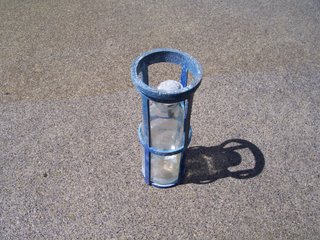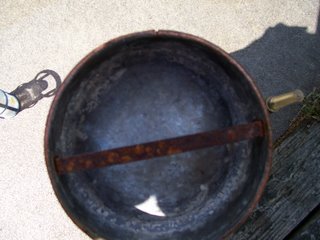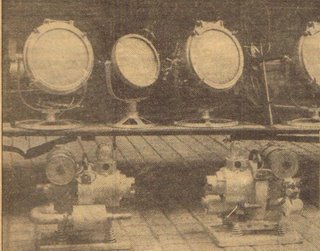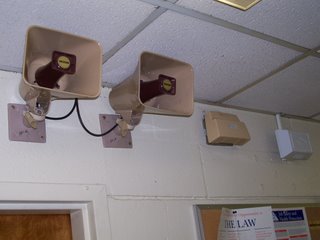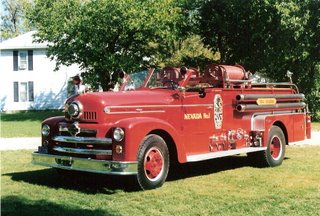
The guys at my station started discussing our hydrants and water supply and it eventually spread to a history lesson. Some of the history I knew, some I had to research. Before there were municipal water systems fighting fire with water took some strategy. In China, firefighting cauldrons were used to store water in locations around the cities and during outbreaks of fire people would carry their buckets to the cauldron and dip out water to use for firefighting. The municipal water system debuted and resembled a faucet, from which the old bucket brigade method would operate, filling the buckets and shuttling them to the fire. This system was used as a public water supply, until fire broke out. In the colonial era fire cisterns, large underground tanks or structures, were employed to hold water to be pumped for fighting fires. One source notes that Louisville, KY employed 124 cisterns and no hydrants, and some cities still have operating fire cisterns.
The term ‘fire plug’ is a colloquial for fire hydrant, as is ‘johnny pump’. The origin of the fire plug is from the 1600s. During this time responding firefighters, upon arrival at a fire scene would dig up the existing water main and drill/bore/smash a hole into it for the purpose of securing water for firefighting operations. This was utilized via bucket brigades and later hand operated fire pumps. After the firefighting operations were finished the holes were plugged with stoppers that eventually became known as fire plugs which is how fire hydrants eventually became known as fire plugs. London, in 1666, experienced the “great fire of London” and afterwards installed water mains with predrilled holes at given intervals and risers and they installed plugs at the street level to reduce the time it took to get water.
The inventor of the fire hydrant system is a mystery. There have been several people credited with innovations regarding hydrants. Hydrants come in many sizes, shapes, and colors. In our area, as with most, our hydrants are color coded (Blue, Green, Yellow/Orange, and Red in descending GPM rates) to help identify the amount of available water. There are several underground variations at places like airports. In the UK hydrants are located in the ground and have yellow ‘H’ signs to indicate the location for firefighters. In Finland they use a similar system, only their signs are blue. The signs (or other signs nearby) also note 2 numbers which indicates the size of the water main in millimeters (a top number) and the distance it is from the hydrant (the bottom number). Some of the older signs may express the numbers in Imperial Units.
I have found several styles of hydrants from around the world. There are many different colors and shapes of each type. I have listed as many as I can find below. There is a link to a great information site on the right and it has links to information pages for each of the listed copanies. This site has a wealth of information that I can’t give enough justice to.
American Darling Valve
American Foundry and Mfg. Co
American Valve & Hydrant
American AVK Company
AVK
H.W. Clark Co (Illinos)
Barbará (Brazil)
Bayard
Clow Canada
Clow Valve CorpCulan Slan Iron Works
Danfoss Esco AS (Norway)
East Jordan Iron Works (EJIW) (Michigan)
Eddy Valve Co.
Elkhart Brass Mfg Co
Eisenwerk Rödinghausen (Germany)
Erhard (Germany)
FUMOSAC (Peru)
Fumosa (Peru)Fundición Gamboa (Mexico)
James Jones Co. (California)
J.J.N. Ltda. (Columbia)John Fox & Co – NYC
Karya Puyasa (Indonesia)
Kennedy Valve (New York)
Kitagawa Iron Works Co., Ltd. (Japan)
Knowsley SK, LTD (UK)
Kupferle Foundry (Missouri)
Ludlow-Rensselaer (Ohio)
M&H Valve & Fitting Co. (Alabama)Gould HydrantGratz-Bohm
E. Hawle & Co Armaturenwerke (Austria)Hays Mfg. Co. - Erie, PA J.H.Heathman - LondonHinman Hydraulic Mfg (Colorado)Ideal Hydrants and StreetwashersC. M. Kemp Iron and Wood Case HydrantsShand Mason & Co - UK McKim Foundry & Machine Co (New York)
McNamara Pattern HydrantsMerryweather - London, UKModern Iron Works - Quincy, ILMonarch Forge & Machine Works (Oregon)Mueller (Alabama)
A.J. Morse and SonNapa Pump and Mfg CoPacific Tank & Pipe Co (Oregon)Pittsburgh Filter Mfg Co (Pennsylvania)
Plueger & Henger Mfg. CoSomerville & Leitch - Washington, DC
Saint-Gobain CanalizaçãoT & S
Maezawa (Japan)Tibb
Thomas McAvity & CompanyWaterworks Equipment Co – NYC
Mittelmann Armaturen (Germany)
Mueller Canada Canada Valve Ltd.Canada Valve and Hydrant Co. Ltd.Dominion Steel Products Company (Canada)
Murdock, Inc. (Ohio)
Olympic Foundry Company (Washington)
Penn-Troy Machine Corp. (Pennsylvania)
Pont-à-Mousson (France)
Raphael Valves Industries Ltd. (Israel)
Saint-Gobain PAM (France)
De Sanno Industries
Service Brass
Desco
Shilla Fire Co., Ltd. (Korea)
Terminal City Iron Works ACS Inc (Canada)
Universal Flow Engineering (Canada)
US Pipe and Foundry (Tennessee)
VAG-Armaturen GmbH (Germany)
Bopp & Reuther GmbH (Germany)
Vazhod J.S.C. (Bulgaria)
Von Roll (Switzerland)
Waterous Engine Works Co., Ltd (Minnesota)Waterous Company (Minnesota)
Yokoi Mfg. Ltd. (Japan)
ZET Marketing & Trade (Japan)
Glenfield & Kennedy, Ltd. (Scotland)
Ham Baker & Co. Limited (England)
Johnson City Foundry & Machine Works, Inc. (Tennessee)
Cayuta Wheel and Foundry Company (Pennsylvania)National Car Wheel Company (Pennsylvania)
Ramsay's Machine Works (Canada)
Tamaqua Mfg. Co. (Pennsylvania)
Wolff & Zwicker Iron Works (Oregon)
Windsor Foundry (Nova Scotia)
The Vulcan (Canada)
Utica Pipe Foundry Company (New York)
J. Tylor & Sons (England)Tylors of London (England)Tylors (Water & Sanitary) Limited (England)Tylors (Division of Crane) (England)Crane, Tylors Division (England)
Three Rivers Iron Works (Canada)
Some of these companies are the results of mergers and renaming efforts of the existing companies. There are definitely more companies that make hydrants but I haven’t found their names yet. If you know of more feel free to drop me a line and I will add them to my list.

A picture from Eygpt (I think) showing the old 'faucet' style hydrants
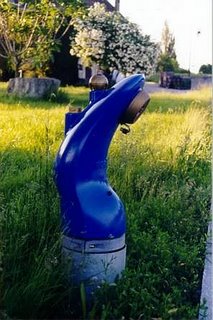
I don't know the ake of this hydrant but it is different
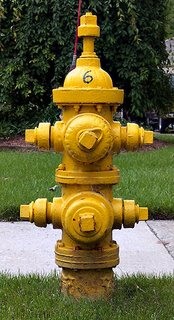 I hope whoever this hydrant belongs to has a strong main attached to it with that many connections
I hope whoever this hydrant belongs to has a strong main attached to it with that many connections
 Artist rendering of working fire with the firemen using a flip top style hydrant
Artist rendering of working fire with the firemen using a flip top style hydrant
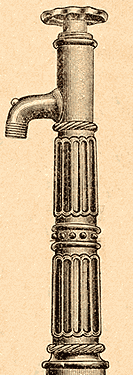 Drawing of an old 'faucet' type hydrant
Drawing of an old 'faucet' type hydrant
 Cauldron (from China) used for bucket brigades
Cauldron (from China) used for bucket brigades



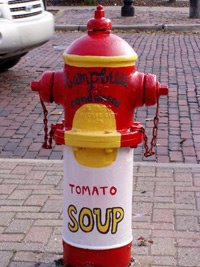
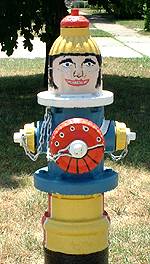
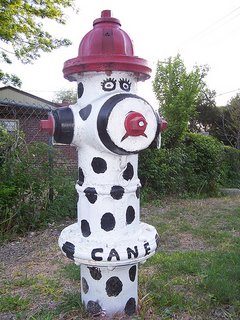




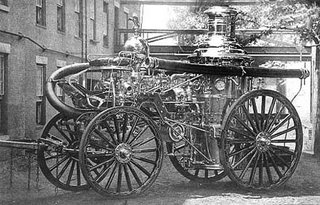

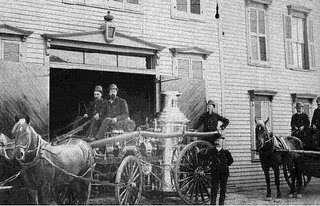
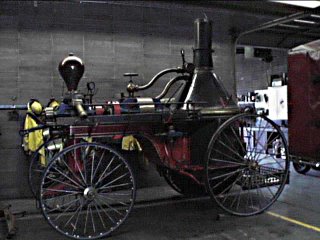



 A picture from Eygpt (I think) showing the old 'faucet' style hydrants
A picture from Eygpt (I think) showing the old 'faucet' style hydrants I don't know the ake of this hydrant but it is different
I don't know the ake of this hydrant but it is different I hope whoever this hydrant belongs to has a strong main attached to it with that many connections
I hope whoever this hydrant belongs to has a strong main attached to it with that many connections Artist rendering of working fire with the firemen using a flip top style hydrant
Artist rendering of working fire with the firemen using a flip top style hydrant Drawing of an old 'faucet' type hydrant
Drawing of an old 'faucet' type hydrant Cauldron (from China) used for bucket brigades
Cauldron (from China) used for bucket brigades








